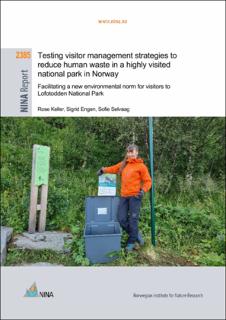| dc.contributor.author | Keller, Rose | |
| dc.contributor.author | Engen, Sigrid | |
| dc.contributor.author | Selvaag, Sofie | |
| dc.date.accessioned | 2023-12-19T22:51:04Z | |
| dc.date.available | 2023-12-19T22:51:04Z | |
| dc.date.issued | 2023 | |
| dc.identifier.isbn | 978-82-426-5189-1 | |
| dc.identifier.issn | 1504-3312 | |
| dc.identifier.uri | https://hdl.handle.net/11250/3108279 | |
| dc.description.abstract | Keller, R., Engen, S. & Selvaag, S. 2023. Testing visitor management strategies to reduce human waste in a highly visited national park in Norway. NINA Report 2385. Norwegian Institute for Nature Research.
In 2021, the Norwegian Institute for Nature Research (NINA) carried out waste surveys (i.e., mapped the presence of different types of waste such as human fecal material and toilet paper, wet wipes, plastic, tabacco products, foil, and other litter) in Lofotodden National Park (NP). The background for the investigations was that the national park administration expressed concern about increased visitor numbers and the impact on the environment. The Lofotodden NP man-ager and protected area board also reported that the local population noticed more waste, including human feces, especially in the Kvalvika area. These investigations showed that human feces made up a large part of the waste, and that it impacted the water quality in the area. It was therefore decided that further investigations were needed to confirm the source of fecal pollution in surface water and understand the potential consequences of human waste on the visitor ex-perience and the natural values of the area, including biodiversity in streams. We also determined we needed to understand the likelihood of visitors adopting future measures to deal with human feces. By the end of 2021 and throughout 2022 we developed a thorough protocol for assessing both the quantity of feces and the impact on water quality and visitors, along with a series of visitor surveys and interview questions to derive a tailored solution for reducing feces accumulation in highly popular areas in Kvalvika in Lofotodden NP.
In this report, we describe the final results from our mixed methods study on visitor impacts and behavior, along with the experience of visitors to the Kvalvika area using the Biffy bag portable toilet. We document how human feces and toilet paper left behind in the park can affect visitors’ experience of nature, as well as impact the water quality and health of visitors. We also describe human health and environmental effects (i.e., water quality of local streams) from human waste during the control periods (no Biffy bags) compared to the improvement in water quality in the treatment periods (Biffy bags given to visitors). Finally, we conclude with recommendations for further measures, as well as the need for further research to understand the long-term effects of encouraging visitors to use toilet bags in Lofotodden National Park. | en_US |
| dc.description.abstract | Keller, R., Engen, S. & Selvaag, S. 2023. Testing visitor management strategies to reduce human waste in a highly visited national park in Norway. NINA Report 2385. Norwegian Institute for Nature Research.
I 2021 gjennomførte Norsk Institutt for Naturforskning (NINA) avfallsundersøkelser i Kvalvika i Lofotodden nasjonalpark. Blant undersøkelsene inngikk en kartlegging av mengden av ulike typer avfall som menneskelig avføring, toalettpapir, våtservietter, plast, sigarettsneiper, snus og metall i et begrenset område. Undersøkelsene ble gjort med bakgrunn i at nasjonalparkforvaltningen uttrykte bekymring for økende besøksantall og påvirkningene dette kunne ha på naturen. Nasjonalparkforvalteren og nasjonalparkstyret rapporterte også at lokale ga uttrykk for en økning i mengde avfall, inkludert menneskelig avføring og toalettpapir, spesielt i Kvalvikaområdet. Avfallsundersøkelsene i 2021 viste at menneskelig avføring og toalettpapir utgjorde en stor andel av avfallet og at det påvirket vannkvaliteten i området. Det ble derfor bestemt at videre undersøkelser var nødvendige for å kunne vurdere omfanget av forurensningen og for å forstå konsekvensene menneskelig avføring kan ha for besøksopplevelsen og naturverdiene i området. Det ble også fokusert på tiltak som kunne gjennomføres for å redusere avfallet og på hva de besøkende mente om eksisterende do atferd og muligheten for å endre denne. I 2022 ferdigstilte vi en detaljert protokoll for å dokumentere mengde toalettavfall etterlatt i naturen og påvirkningen dette har på vannkvaliteten og besøksopplevelsen. Vi gjennomførte også en rekke brukerundersøkelser og intervjuer for å utvikle passende tiltak for å redusere toalettavfall på de mest brukte områdene i Kvalvika.
I denne rapporten beskriver vi resultater fra studien om menneskelige påvirkninger og atferd knyttet til toalettavfall ved Kvalvika og uttesting av toalettposer (Biffy bags) sommeren 2023. Dette er tilpassede poser som kan tas med på tur og kastes i avfallscontainere etter bruk. I rapporten viser vi hvordan dagens nivå av menneskelig avføring i området kan ha negativ effekt på vannkvalitet og påvirke folks helse. Avslutningsvis kommer vi med anbefalinger for videre tiltak, samt behov for ytterligere forskning for å forstå langtidseffektene av å oppfordre besøkende til å bruke toalettposer i Lofotodden nasjonalpark. | |
| dc.description.sponsorship | Miljødirektoratet: M-2638|2023 | en_US |
| dc.language.iso | eng | en_US |
| dc.publisher | Norwegian Institute for Nature Research (NINA) | en_US |
| dc.relation.ispartofseries | NINA Report;2385 | |
| dc.subject | human waste management | en_US |
| dc.subject | communication theory | en_US |
| dc.subject | visitor Management | en_US |
| dc.subject | menneskelig avfallshåndtering | en_US |
| dc.subject | kommunikasjonsteori | en_US |
| dc.subject | besøksforvaltning | en_US |
| dc.title | Testing visitor management strategies to reduce human waste in a highly visited national park in Norway. Facilitating a new environmental norm for visitors to Lofotodden National Park | en_US |
| dc.type | Research report | en_US |
| dc.rights.holder | © Norwegian Institute for Nature Research. The publication may be freely cited where the source is acknowledged | en_US |
| dc.source.pagenumber | 53 | en_US |
